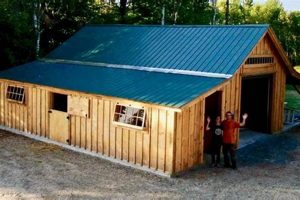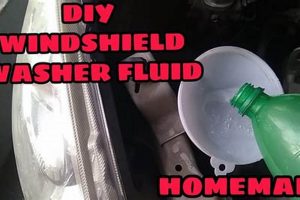The practice of independently mitigating the presence of a colorless, odorless, radioactive gas within a residential structure constitutes a specific approach to environmental remediation. This approach involves homeowners undertaking measures to reduce concentrations of the gas, often employing commercially available kits and following provided instructions. For instance, installing a sub-slab depressurization system, typically involving drilling a hole in the foundation and venting the gas outside, falls under this category.
Addressing elevated levels of this particular gas is important due to its classification as a significant health hazard and its association with increased risks of respiratory illnesses. Historically, mitigation efforts were largely handled by certified professionals; however, increased accessibility of testing and mitigation materials has led to greater homeowner involvement. Successfully decreasing its concentration contributes to improving indoor air quality and safeguarding the health of occupants.
The subsequent sections will delve into critical aspects related to understanding the potential challenges, evaluating appropriate methodologies, and exploring considerations for long-term monitoring following independent mitigation strategies. Careful planning and execution are paramount to achieving effective and sustainable results.
DIY Radon Removal
Effective independent radon mitigation requires careful planning and precise execution. Adhering to established protocols is crucial for achieving lasting results and ensuring occupant safety.
Tip 1: Thorough Testing is Imperative: Prior to initiating any mitigation strategy, conduct a comprehensive radon test using a certified testing kit. Follow the kit’s instructions meticulously. Short-term tests provide a rapid assessment, while long-term tests offer a more accurate representation of average annual radon levels.
Tip 2: Understand Local Building Codes and Regulations: Investigate local building codes and regulations pertaining to radon mitigation. Certain jurisdictions may mandate permits or specific installation standards for ventilation systems or other mitigation measures.
Tip 3: Prioritize Sub-Slab Depressurization: For homes with slab foundations, sub-slab depressurization is generally considered the most effective mitigation technique. This method involves creating a vacuum beneath the slab to draw radon gas away from the house before it can enter.
Tip 4: Ensure Proper Sealing: Seal all cracks and openings in the foundation walls and slab. This will prevent radon gas from entering the home through these pathways. Use appropriate sealant materials designed for concrete and masonry.
Tip 5: Professional Fan Selection is Recommended: When installing a sub-slab depressurization system, select a fan specifically designed for radon mitigation. Consult with a qualified professional or review manufacturer specifications to ensure the fan provides adequate airflow and static pressure for the home’s characteristics.
Tip 6: Vent Discharge Point Matters: The vent discharge point must be located away from windows, doors, and air conditioning intakes. The exhaust must meet the minimum height requirements specified by local codes to prevent radon from re-entering the building.
Tip 7: Post-Mitigation Testing is Crucial: Following the completion of the mitigation project, conduct another radon test to verify the effectiveness of the system. This post-mitigation test will confirm whether the radon levels have been reduced to an acceptable level.
Successfully reducing radon concentrations depends on diligent adherence to these guidelines and a commitment to thoroughness. Neglecting any of these steps could compromise the effectiveness of the mitigation effort.
The concluding section will address long-term monitoring strategies and offer final recommendations for maintaining a radon-safe environment.
1. Thorough Initial Testing
Thorough initial testing forms the foundation of any effective independent radon mitigation endeavor. Accurate assessment of baseline radon levels is essential for determining the necessity and scope of mitigation efforts. Without precise data, the homeowner risks undertaking unnecessary or insufficient remediation measures. Elevated radon concentrations identified during testing provide the impetus for implementing mitigation strategies.
The effectiveness of subsequent mitigation procedures is directly linked to the accuracy of the initial testing. For example, a short-term test conducted during a period of unusually high radon concentration may prompt an unnecessary mitigation project, while a test performed under ideal circumstances may underestimate the true annual average exposure, leading to inadequate protection. Long-term alpha track detectors provide a more reliable estimate and are therefore recommended. Improperly conducted tests, such as those performed during home renovations or with windows open, can lead to inaccurate readings and flawed decision-making.
The failure to prioritize proper testing undermines the entire process of mitigating radon through independent means. It can result in wasted resources, continued exposure to dangerous levels of the gas, and a false sense of security. Therefore, adhering strictly to test protocols and utilizing appropriate testing methods are indispensable prerequisites to pursuing any self-directed remediation approach. This initial step is pivotal for establishing a data-driven strategy and gauging the success of subsequent interventions.
2. Code Compliance Verification
Code compliance verification constitutes a critical, yet often overlooked, element of independent radon mitigation. Adherence to established building codes and environmental regulations ensures that mitigation efforts are conducted safely and effectively, protecting both occupants and the surrounding environment.
- Permitting Requirements
Many jurisdictions mandate permits for radon mitigation work, regardless of whether it is performed by a professional or a homeowner. Obtaining the necessary permits ensures that the project undergoes review by local authorities, confirming that the proposed mitigation system meets minimum safety standards. Failure to secure a permit can result in fines, project delays, or even the requirement to dismantle non-compliant installations.
- Ventilation System Standards
Building codes often dictate specific requirements for the design and installation of radon ventilation systems. These standards may address factors such as the diameter and material of vent pipes, the location of the exhaust point relative to windows and air intakes, and the capacity of the ventilation fan. Compliance with these standards ensures that the system effectively removes r
adon gas without creating other hazards, such as backdrafting or noise pollution. - Electrical Safety Regulations
Radon mitigation systems typically involve the installation of electrical components, such as ventilation fans and monitoring devices. Adherence to electrical safety codes is paramount to prevent electrical shocks, fires, or other hazards. Proper wiring, grounding, and protection from moisture are essential for ensuring the safe operation of the mitigation system.
- Disposal of Contaminated Materials
Certain radon mitigation activities may generate contaminated materials, such as soil or dust containing elevated levels of radon. Local regulations may dictate specific procedures for the safe handling and disposal of these materials to prevent environmental contamination. Compliance with these regulations ensures that the disposal process does not pose a risk to human health or the environment.
The interplay between code compliance verification and independent radon mitigation underscores the importance of informed decision-making. Ignoring regulatory requirements can lead to costly mistakes, safety hazards, and legal repercussions. By diligently researching and adhering to applicable codes, homeowners can ensure that their mitigation efforts are both effective and compliant with local regulations, ultimately promoting a safer and healthier living environment.
3. Sub-Slab Depressurization Priority
Sub-slab depressurization (SSD) constitutes a primary and often indispensable method within independent radon mitigation efforts. The underlying principle involves creating a negative pressure field beneath the building’s foundation, effectively drawing radon gas away from the structure before it can infiltrate living spaces. The effectiveness of this approach stems from its direct intervention at the source of radon entry, addressing a common pathway in homes with slab foundations. For example, in a residence with cracks and fissures in the concrete slab, radon gas can easily permeate upwards. An SSD system mitigates this by actively venting the gas to the exterior, significantly reducing indoor concentrations. Prioritizing SSD ensures that the most impactful mitigation technique is employed as the initial strategy.
The implementation of SSD as a priority within independent mitigation is exemplified in various scenarios. A homeowner in the Midwestern United States, detecting elevated radon levels, might choose to install an SSD system as their first line of defense. This typically involves sealing cracks in the foundation, drilling a hole through the slab, inserting a vent pipe, and connecting a fan to exhaust the radon gas outdoors. Success depends on correctly sizing the fan to generate sufficient negative pressure and ensuring that the venting system adheres to local building codes. If subsequent testing reveals that radon levels remain high, additional measures, such as improving ventilation or sealing additional entry points, may be considered. However, the initial focus on SSD aims to achieve a substantial reduction in radon levels with a single intervention.
In summary, prioritizing sub-slab depressurization within the context of independently undertaken radon mitigation efforts is driven by its proven efficacy in targeting the primary source of radon entry. While additional mitigation measures may be required in certain circumstances, the strategic application of SSD offers a substantial and proactive approach to reducing indoor radon concentrations. Success requires careful planning, adherence to installation guidelines, and verification through post-mitigation testing to confirm the system’s effectiveness and ensure long-term safety.
4. Effective Foundation Sealing
Effective foundation sealing represents a critical component of successful independent radon mitigation. The integrity of the foundation acts as the primary barrier against the ingress of radon gas into a building. Cracks, gaps, and penetrations in the foundation slab and walls provide pathways for radon to enter, undermining other mitigation efforts. For instance, if a homeowner installs a sub-slab depressurization system but neglects to seal existing foundation cracks, the system’s effectiveness is significantly diminished as radon can still infiltrate through these unsealed openings. Therefore, meticulous sealing forms an essential prerequisite for achieving optimal radon reduction during self-directed mitigation projects.
The practical application of effective sealing encompasses several techniques and materials. Cracks in concrete slabs should be filled with a suitable epoxy or polyurethane sealant designed for concrete repair. Gaps around pipe penetrations, such as those for plumbing or electrical conduits, should be sealed with a non-shrinking, flexible sealant. Additionally, open sump pits, often present in basements, should be covered and sealed to prevent radon from entering the living space. A real-world example involves a homeowner discovering elevated radon levels despite having installed a basic ventilation system. Upon closer inspection, they identified numerous unsealed cracks in the foundation walls. After thoroughly sealing these cracks, subsequent testing revealed a substantial reduction in radon concentrations, demonstrating the direct impact of effective sealing.
In conclusion, effective foundation sealing is not merely a supplementary step but an integral element of any self-managed radon mitigation strategy. Addressing foundation vulnerabilities preemptively maximizes the efficacy of other mitigation techniques, such as sub-slab depressurization, and contributes significantly to reducing indoor radon concentrations. While challenges may arise in identifying and accessing all potential entry points, the commitment to thorough sealing ensures a more successful and sustainable reduction of radon levels, ultimately safeguarding the health of building occupants.
5. Appropriate Fan Selection
In the context of independent radon mitigation, the selection of an appropriate fan is not merely a matter of choosing a readily available ventilation device. It represents a critical decision that directly impacts the effectiveness and longevity of the mitigation system.
- Airflow and Static Pressure Requirements
The selected fan must be capable of delivering adequate airflow at the necessary static pressure to effectively extract radon gas from beneath the building’s foundation. Insufficient airflow will compromise the system’s ability to create a negative pressure field, while inadequate static pressure will prevent the fan from overcoming resistance within the ventilation system. Manufacturers’ specifications should be carefully reviewed to ensure that the fan’s performance characteristics align with the specific requirements of the building and soil conditions.
- Fan Type and Design Considerations
Radon mitigation fans are specifically designed to operate continuously and reliably under the conditions encountered in sub-slab ventilation systems. These fans typically feature sealed housings to prevent radon
leakage and are constructed from durable materials that can withstand exposure to moisture and temperature fluctuations. Standard household fans are generally unsuitable for radon mitigation due to their lower airflow capacity, shorter lifespan, and lack of radon-resistant construction. - Noise Level and Vibration
Given that radon mitigation systems often operate continuously, noise levels and vibration are important considerations. Excessively noisy fans can disrupt the comfort of occupants, while vibration can lead to premature wear and tear on the system components. Choosing a fan with a low noise rating and incorporating vibration isolation measures, such as rubber mounts, can help to minimize these issues.
- Energy Efficiency and Operating Costs
Continuous fan operation can result in significant energy consumption over time. Selecting an energy-efficient fan can help to minimize operating costs and reduce the environmental impact of the mitigation system. Look for fans with high energy efficiency ratings and consider models with variable speed controls to optimize airflow and reduce energy consumption during periods of low radon concentration.
The choice of an appropriate fan is a determinant of success or failure for a independently installed radon reduction system. The fan choice must align with the particular parameters of the structure for the system to maintain ongoing effectiveness. Failure to account for such considerations undermines the value of the entire project. Thus, due diligence is paramount during the equipment selection phase.
6. Post-Mitigation Validation
Post-mitigation validation represents an indispensable step following any independent radon removal undertaking. This process confirms whether the implemented mitigation strategies have achieved the desired reduction in indoor radon concentrations, ensuring occupant safety and validating the effectiveness of the homeowner’s efforts.
- Confirmation of Radon Reduction
The primary objective of post-mitigation validation is to ascertain that radon levels have been reduced to an acceptable range, typically below the EPA’s action level of 4 picocuries per liter (pCi/L). This is accomplished through conducting follow-up radon tests, ideally using long-term testing methods to account for fluctuations in radon concentrations over time. For example, a homeowner who installed a sub-slab depressurization system would perform a new radon test several weeks after installation to verify that the system is functioning correctly and effectively reducing radon levels. A reading above the action level would necessitate further investigation and adjustments to the mitigation system.
- Assessment of System Performance
Beyond simply measuring radon levels, post-mitigation validation also involves assessing the overall performance of the mitigation system. This may include inspecting the system components for proper installation and functionality, verifying airflow rates in ventilation systems, and checking for any signs of damage or deterioration. As an illustration, a homeowner might visually inspect the vent pipe of a sub-slab depressurization system to ensure it is free of obstructions and that the fan is operating smoothly. Any anomalies detected during this assessment could indicate the need for repairs or modifications to maintain the system’s effectiveness.
- Long-Term Monitoring Protocols
Post-mitigation validation should not be viewed as a one-time event but rather as an ongoing process. Establishing long-term monitoring protocols is essential to ensure that radon levels remain within acceptable limits over time. This typically involves periodic radon testing, such as annual or biennial testing, to detect any potential changes in radon concentrations due to factors such as soil conditions, building renovations, or system malfunctions. A homeowner who consistently monitors radon levels can proactively identify and address any emerging issues, preventing prolonged exposure to elevated radon concentrations.
- Documentation and Record Keeping
Maintaining thorough documentation and records of all radon testing and mitigation activities is crucial for post-mitigation validation. This includes recording the dates and results of all radon tests, details of the mitigation system installation, and any subsequent repairs or modifications. This documentation provides a valuable history of radon levels and mitigation efforts, which can be useful for future reference, property transactions, or regulatory compliance. A homeowner who meticulously documents their radon mitigation efforts demonstrates a commitment to transparency and responsible environmental stewardship.
Linking back to the theme, proper validation of the radon removal is critical for anyone performing a DIY project. Validation and consistent monitoring is what makes the project a success. The homeowner that does not monitor the effectiveness of the project does not know if they are saving their loved ones from a dangerous gas. Proper validation is an integral part of any project.
Frequently Asked Questions
The following questions address common concerns regarding independently undertaken radon mitigation projects. Understanding these points is crucial for homeowners considering this approach.
Question 1: Is independent radon mitigation a safe alternative to professional services?
The safety of independent radon mitigation hinges on adherence to established protocols, accurate testing, and diligent workmanship. When performed correctly, following EPA guidelines and local codes, it can be a viable alternative. However, lack of experience and potential for errors can pose risks. Improper installation of ventilation systems, for example, can lead to backdrafting or electrical hazards.
Question 2: What are the most common mistakes made during independent radon mitigation?
Frequent errors include inadequate sealing of foundation cracks, improper fan selection (insufficient airflow or static pressure), incorrect placement of vent discharge points, and failure to conduct post-mitigation testing. Ignoring local building codes and failing to obtain necessary permits are also common oversights. These mistakes compromise the system’s effectiveness and may create safety hazards.
Question 3: How can the effectiveness of an independent radon mitigation system be verified?
Effectiveness is verified through post-mitigation radon testing. A long-term test, conducted over several months, provides the most accurate assessment of average radon levels. If radon concentrations remain above the EPA’s action level of 4 pCi/L, further investigation and system adjustments are necessary.
Question 4: What are the legal and regulatory considerations for independent radon mitigation?
Legal and regulatory considerations vary by jurisdiction. Many localities require permits for radon mitigation work and adherence to specific building codes related to ventilation systems and electrical installations. Failure to comply with these regulations can result in fines, project delays, or the requirement to dismantle non-compliant installations. It is the homeowner’s responsibility to research and adhere to all applicable regulations.
Question 5: What are the long-term maintenance requirements for a independently installed radon mitigation system?
Long-term maintenance typically involves periodic in
spection of the system components, including the ventilation fan and vent pipes, to ensure they are functioning correctly. Fans may require replacement after several years of continuous operation. Regular radon testing is also essential to monitor radon levels and detect any potential system malfunctions or changes in soil conditions.
Question 6: What are the cost savings associated with independent versus professional radon mitigation?
Cost savings can be significant, as homeowners avoid labor costs associated with professional installation. However, independent mitigation requires the homeowner to purchase all materials and equipment, as well as invest their own time and effort. Potential cost savings must be balanced against the risk of errors, the time commitment involved, and the need for specialized knowledge and skills.
In conclusion, independent radon mitigation can be a viable option for informed and diligent homeowners. However, it requires a thorough understanding of radon behavior, mitigation techniques, and applicable regulations. Careful planning, meticulous execution, and ongoing monitoring are essential for ensuring the safety and effectiveness of the mitigation efforts.
The subsequent section will delve into resources for further learning and support regarding independent radon mitigation projects.
Conclusion
This exploration of independent radon mitigation has underscored the complexities inherent in addressing a significant environmental health hazard. The decision to undertake “diy radon removal” necessitates a comprehensive understanding of testing protocols, mitigation techniques, code compliance, and ongoing monitoring. Success hinges on meticulous planning, precise execution, and a commitment to long-term maintenance.
While the prospect of cost savings may be appealing, the potential consequences of improper mitigation cannot be overstated. Homeowners contemplating this approach must carefully weigh the risks and benefits, ensuring they possess the requisite knowledge and skills. Prioritizing occupant safety and adhering to established guidelines are paramount to achieving effective and sustainable radon reduction. Consider professional consultation when uncertainty arises; a health hazard is best addressed by due diligence.





![DIY Build: Circular Saw Crosscut Jig PDF Plans [Free] The DIY Hub: Creative Crafts, Repairs & Life Hacks DIY Build: Circular Saw Crosscut Jig PDF Plans [Free] | The DIY Hub: Creative Crafts, Repairs & Life Hacks](https://craftingdiycenter.com/wp-content/uploads/2025/07/th-5916-300x200.jpg)

